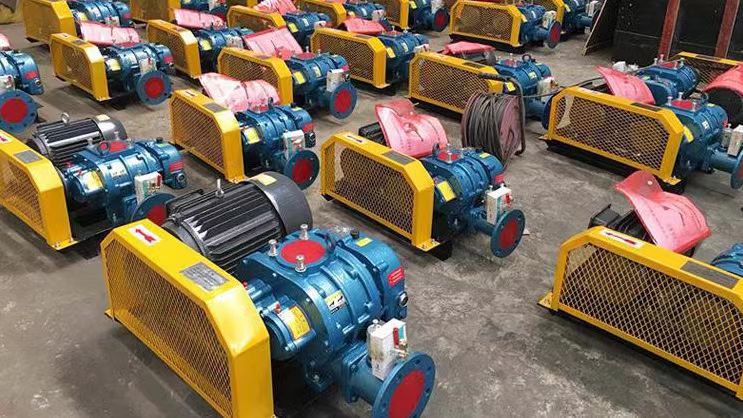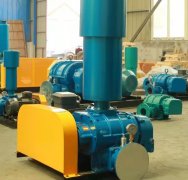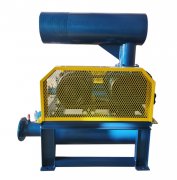The following is a professional selection, installation, and usage guide for the Roots blower for fish pond oxygenation, covering special requirements and optimization solutions for aquaculture scenarios:
---

**1、 Characteristics of Roots blower for fish pond oxygenation**
**1. Core requirements**
-Stable oxygen supply: requires 24-hour continuous operation with fluctuations ≤ 5.
-* * Low noise * *: ≤ 75dB (to avoid disturbing fish).
-Moisture resistant: IP55 protection level, rust proof motor casing.
-* * Energy saving * *: Electricity costs account for more than 30% of the breeding cost, depending on the model.
**2. Difference from ordinary Roots blower**
|* * Project * * | * * Oxygenation specific type * * | * * Industrial universal type * *|
|----------------|----------------------------|--------------------------|
|* * Material * * | Stainless steel rotor+anti algae coating | Ordinary carbon steel|
|* * Sealing * * | Double mechanical seal (waterproof) | Single layer labyrinth seal|
|Lubrication system * * | Fully enclosed oil bath lubrication (maintenance free) | Open gear oil lubrication|
---
**2、 Selection calculation and parameter matching**
**1. Estimation of Oxygen Demand in Fish Ponds**
-* * Formula * *:
\( Q = A \times D \times K \)
-(Q): Required air volume (m3/min)
-(A): Water surface area (mu, 1 mu ≈ 667m2)
-(D): Water depth (meters)
-(K): Coefficient (0.3~0.5, high value for high temperatures in summer)
-* * Example * *:
5 acres of fish pond, water depth of 2 meters → (Q=5 \ times 2 \ times 0.4=4 \, \ text {m3/min} \)
**2. Recommended fan parameters**
|* * Fish pond scale * * | * * Fan power * * | * * Air volume (m3/min) * * | * * Aeration pipe configuration * *|
|----------------|-------------|--------------------|-------------------------|
|1-3 acres | 1.5~3kW | 1.5~3.5 | DN40 nanotubes, spaced 5 meters apart|
|3~10 acres | 4~7.5kW | 4~8 | DN63 micro porous discs, spaced 8 meters apart|
|10-20 acres | 11-15kW | 10-15 | DN75 rotary mixing aerator|
---
**3、 System composition and installation**
**1. Essential components**
-Host: Roots blower (recommended three blade low-noise type).
-Aeration device:
-* * nanotubes * * (low cost, easy to clog, suitable for small ponds).
-* * Spin mixing aeration disc * * (oxygen utilization rate>30, lifespan of 5 years+).
-* * Auxiliary equipment * *:
-Check valve (anti backflow), pressure gauge (monitoring back pressure).
-Silencer (waterproof cover needs to be installed outdoors).
**2. Installation points**
-* * Location selection * *:
-Distance from fish pond ≤ 20 meters, in a ventilated and dry place (avoid direct sunlight).
-Pipeline layout:
-The supervisor (PVC pipe) is buried for antifreeze, and the branch pipe (hose) is fixed with stainless steel clamps.
-The aerator is evenly distributed 30-50cm away from the bottom of the pond.
-* * Electrical * *:
-Configure a leakage protection switch, with a motor grounding resistance of ≤ 4 Ω.
---
**4、 Operation, maintenance, and troubleshooting**
**1. Daily Maintenance Table**
|* * Project * * | * * Operation * * | * * Cycle * *|
|-------------------|--------------------------|------------------|
|Check the air volume | Observe whether the distribution of bubbles is uniform | Daily|
|Clean the intake filter | Rinse with clean water and air dry | Weekly|
|Monitoring motor temperature | Infrared thermometer (≤ 65 ℃ normal) | Monthly|
|Lubricate bearings | Add water-resistant lithium grease | Every 3 months|
**2. Common problem solving**
|* * Fault * * | * * Cause * * | * * Emergency Response * *|
|-------------------|------------------------|-------------------------|
|Uneven aeration | Pipeline water accumulation/aerator blockage | Drain the accumulated water and clean the aerator with oxalic acid|
|* * Fan abnormal noise * * | Bearing water ingress or wear | Stop the machine and replace the sealing ring and bearing|
|Sudden increase in pressure | Main pipeline rupture or valve misoperation | Stop immediately and check the pipeline|
---
**5、 Energy saving optimization plan**
1. * * Variable frequency control * *:
-When the demand for dissolved oxygen at night is low, adjust to 30Hz operation to save 40% electricity.
2. * * Aerator * *:
-Switch to ceramic microporous discs (with an oxygen transfer efficiency 50% higher than nanotubes).
3. * * Intelligent monitoring * *:
-Install dissolved oxygen sensor+PLC automatic adjustment fan speed.
---
**6、 Cost and benefit analysis**
|* * Project * * | * * 3 acre fish pond example * * | * * 10 acre fish pond example * *|
|------------------|-------------------------------|-----------------------------|
|* * Equipment investment * * | 1.5kW fan+nanotubes ≈ 8000 yuan | 7.5kW fan+mixing disc ≈ 25000 yuan|
|* * Annual electricity bill * * | 1.5kW x 24h x 0.6 yuan x 365 days ≈ 7884 yuan | 7.5kW calculated at the same time ≈ 39000 yuan|
|* * Oxygenation effect * * | Dissolved oxygen ≥ 5mg/L (fish threshold) | Can support high-density aquaculture (yield of 1 ton per mu+)|
---
**7、 Brand recommendation**
|* * Brand * * | * * Features * * | * * Applicable Scenarios * *|
|---------------|------------------------------|-------------------------|
|* * * * | High cost-effectiveness, 1.5-15kW coverage | Small and medium-sized fish ponds|
|* * * * | Silent design (72dB) | Livestock farms near residential areas|
|* * Hitachi * * | Japanese technology, IP68 waterproof | Coastal high salt spray areas|
---
**Tip * *: When selecting a fan, be sure to confirm the aquaculture specific model * * (some industrial models are prone to water damage during long-term operation). If there are special requirements for fish ponds (such as seawater aquaculture, high-density shrimp), customized anti-corrosion enhanced equipment is needed.



